Michele Wipplinger–Recollections on my Mentor
Nancy Zeller
On a fall day in 2005, I was introduced to natural dyeing using plants from local environs, coaxing the colors from plant materials in a caldron over an open fire. We also used a few natural dye extracts for colors that would increase the range of our palette. The extracts were obtained from Earthues, a natural dye company. Almost instantly, I knew natural dyeing would carry my creativity for decades. What I didn’t realize at the time was the path I would take studying with Earthues founder, Michele Wipplinger.
I write this from the prospective of a student of Michele’s, but it would be incongruous not to include the more personal side of my experiences. Soon after I was knocked head over heels with natural dyeing, I contacted Michele in Seattle to ask if I could become a sales rep for Earthues in the Northeast. My husband, Jack, and I have a sheep farm and I had plenty of spun yarns from the wool of our flock of Romeldale/CVM sheep. I had tested the extracts and was ready to take the experience to a higher level. Michele and I worked out an arrangement and I placed my first order for Earthues product. Michele offered to come East to teach at our farm in the fall of 2006. That was the beginning of an annual ritual.
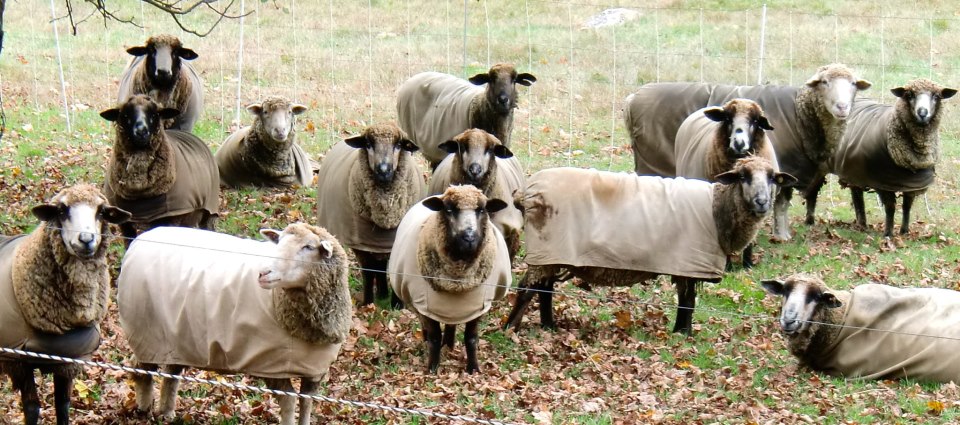
As we planned for the first workshop at the farm, Michele invited me and other artisans and retailers using Earthues natural dyes to a weeklong workshop in July 2006 at her studio in Ballard, a part of Seattle. This was an opportunity for me to study with her and work alongside fellow natural dyers as we propelled our own work forward. This was where I first met Pamela Feldman and Carol Leigh of Hillcreek Fiber Studio. In the coming years I shared the work table with Jay Rich, Donna Hardy, Bobbie Larson and so many more. I made friends for life from these gatherings.
To paint a true picture of studying with Michele, her first gift to her students was in her presentation. Before students arrived, the studio became a stage, a textural color explosion that Michele created meticulously. In time I was privy to watch her methodically work preparing for a workshop and I came to love the first morning entrance into her theatre of color. She wanted students to first see color with their eyes. Her studio in Ballard was a perfect backdrop as the studio floors and walls were covered in natural dyed textiles from around the world, the artisan shop was set to perfection with colors coordinated by hues, dyed products from around the globe, and our workbooks were fully organized and chock full of images she had taken from all her travels, showing examples of natural dyes, both in the making and also in the finished products.
A workshop with Michele, whether it was in her Ballard studio or here at the farm, involved almost more work than the students could complete in the allotted days. In my years studying with Michele I attended, to name a few, Dyeing in the European Tradition, Variegated Painted Sock Yarns, The Reds, The Blues, the Color Institute, Basilan and Traditional Mudcloth. In 2008 I spent a week in Ballard on a personal consultancy with Michele. In each of these experiences, I was both inspired and overwhelmed at the end of each day with the amount of detail and knowledge Michele brought to the work table.
| Michele at the Basilan Workshop, Long Ridge Farms, 2010 | Michele and Nancy Zeller at "The Reds" Workshop, Long Ridge Farms, 2013 |
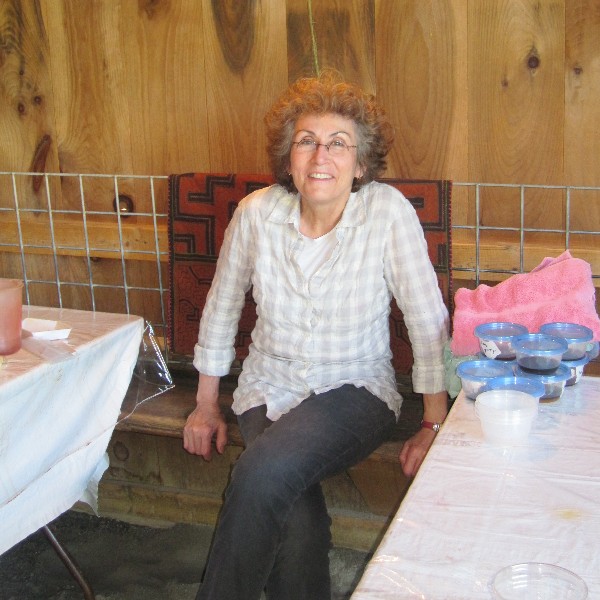 |
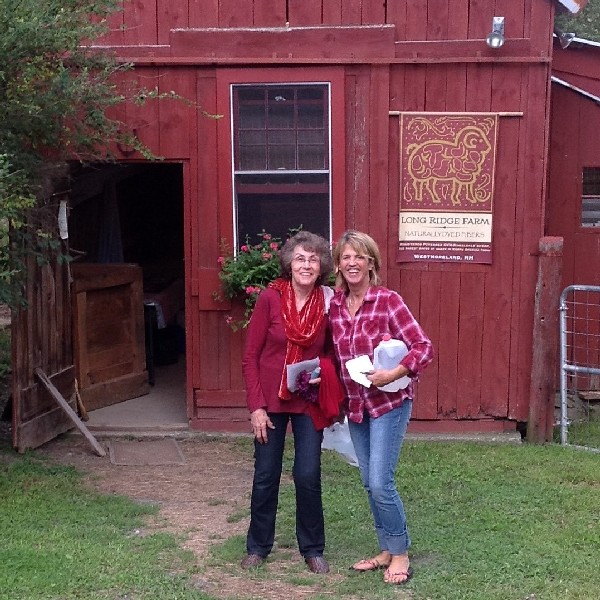 |
| Photograph Copyright by Nancy Zeller | Photograph Copyright by Nancy Zeller |
Michele gave a tremendous amount of time and effort when she taught. In my studies with her two things instantly stand out. Michele taught me how to "see" color. And in that seeing I was taught to test, document and test again when searching for a specific formula to dye. By initially learning through Michele the basics of natural dyeing, how each dye responds to the water temperature, water qualities, even altitude, I was then able to create complex colors using two, three, even four different dyestuffs. In the summer of 2012, a customer asked me to formulate a steel gray for a custom dye order using her skeins of yarn. I worked methodically using all the knowledge I had at the time. But the exact color eluded me, I could not match the photo example the customer gave me to duplicate. Michele was at the farm that summer for her annual workshop and we discussed the issues I was having. She did not present a perfect formula to me, but she did suggest ways for me to push the testing, she guided my research but did not give the answer. I will never forget that lesson, she taught me how to find the answers myself through the training she had given me.
Michele also believed in documentation for each step and detail of natural dyeing. She taught dyeing as a music teacher makes their student learn scales, keys, flats and sharps. Study, write, practice, repeat. I have books full of notes, formulas, corrections and checkmarks for good results. What I learned was that in the repetition and practice, ultimately, I could create a dye formula without a scale. I still need the general guidelines for the formula of dye needed to the weight of goods but to tweak the color as it progresses is no longer an effort. By requiring the details, Michele allowed me to learn at a greater depth for a lifelong natural dye study.
I was always learning when I was with Michele, no matter the locale. If I was in Seattle, we would travel about from the street markets to shops. We would walk and I would listen to her words, what she was seeing and experiencing, because always the theme was color integration and the more I listened the more I came to see color everywhere; in the streets, in the shop window displays, the passersby and the market vendors. It wasn’t that I hadn’t seen with my own eyes, but I had come to learn through Michele’s trained eye. Each year we would visit a fabulous shop in Seattle that sold hundreds of magazines. We rambled through the racks scouring specific issues that focused on color inspiration. During my consultancy in 2008, Michele taught me how to create art boards. I made 4 boards during the week we spent together. I would choose a palette including primary, secondary and hit tones. Once the palette was determined I would go through the magazines, and sometimes from Michele’s images looking for the tones of the palette. Cutting, pasting, creating a visual palette, including matching Pantone chips, was the first step to creating a larger complimentary natural dye palette. Now you can imagine the joy of seeking out inspiring magazines.
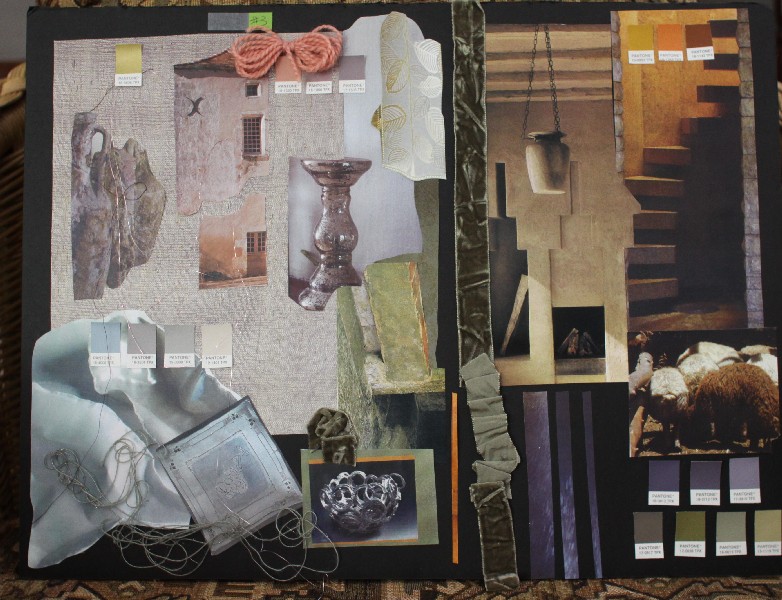
In 2010, I joined a small group of people who also had studied natural dyeing with Michele in Seattle, and we took a two-week art excursion to France. Earthues set the itinerary and it was not to be missed in my opinion. After a few days in Paris we went to Auberge du Presbytere, where we traveled by car each day to study with Michel Garcia at his studio in Lauris. We spent 3 days studying natural dye methods with Michel, using natural dyes for printing and indigo dyeing using alternative methods. He then took us on a walk about Lauris to see the natural dye gardens he started and fostered. From Lauris we traveled further south to visit the Pech-Merle caves and Bleu de Lectoure, the woad dyehouse of Denise Lambert (sadly her husband Henri had passed away in February). We studied dyeing woad with Denise for a few days at Kate Hill’s farm in Ste. Colombe-en-Bruilhois. From there we traveled on to our last destination in Saint Loup en Albret where we visited the Arles, where Van Gogh lived and painted, Mas de la Pyramide and some beautiful brocantes. Because of Michele’s personal relationships with Michel Garcia and Denise Lambert, our group had a truly personal learning experience. The entire journey was another natural dye experience conjured by Michele to offer both a visual and learning smorgasbord.
| Michel Garcia and Michele Wipplinger, Lauris, France, 2010 | Michele Wipplinger and Denise Lambert, Ste. Colombe-en-Bruilhois, France, 2010 |
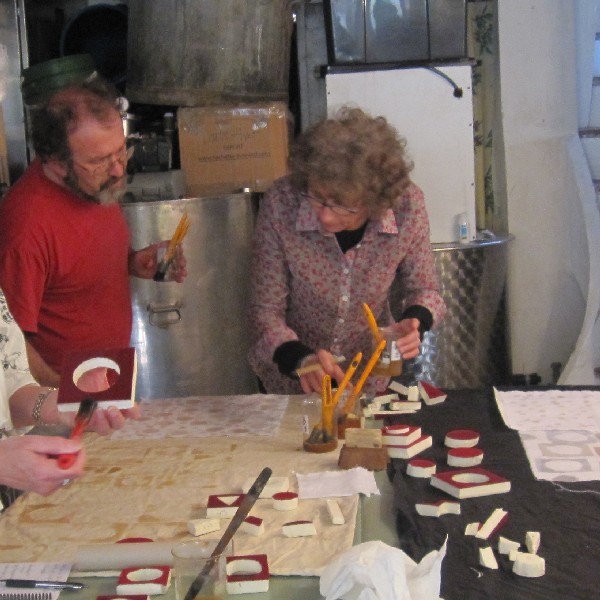 |
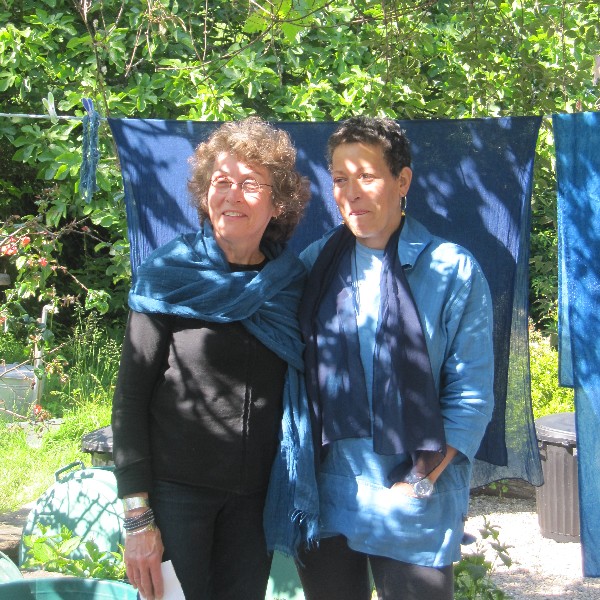 |
| Photograph Copyright by Nancy Zeller | Photograph Copyright by Nancy Zeller |
Michele always provided a wide array of inspiration and visuals during her presentations. I vividly remember a 2009 conference she held in her Ballard studio. She had returned from a trip to Mali, West Africa, where she had delved into documenting the art of Bogolanfini, cotton cloth spun and woven into long strips, hand dyed with mud from the Niger River including local leaves, using fermentation methods to enhance the cloth’s rich shades. The patterns drawn in the mud process chronicle Malian lives, telling stories of rites of passage, hunting and battles through the geometric patterns. Traditionally, women created Bogolanfini, but traditions have evolved, and men and artists now use mud cloth as sociological markers in Malian life. Michele’s experiences in Mali, the bravery of that journey, her deep desire to learn more about an art culture on another continent, bringing home the story, and sharing it with us was mesmerizing. During one of Michele’s storytelling sessions in her Ballard studio, she spoke of a piece of clothing that was displayed. It was an ancient woven vest of cotton, once worn by a warrior, with verses from the Koran written across the entire garment in a dark ink. She told the story of being in Mali and how it was given to her, the experience was very personal to her. Once again, I knew I was in the presence of an artist, a maverick and a leader who shared natural dyeing with the Western world.
In 2013 I had the opportunity to travel to Rwanda and teach for an NGO based in the Northern Province. There, 35 Rwandan women washed, carded spun yarn and dyed it with natural dyes. I taught the women how to increase their dye palette, adding new dyes to their work. I brought the dyestuffs, and with the help of a translator, worked directly with the women. It was challenging due to the language barrier but also completely successful. The cooperative went on to create a better yarn, dyed with a greater selection of colors, and is succeeding in its goals. I know unequivocally that I was able to take on the task as a result of the years of learning and training I received from Michele. I had no fear of failure, because I had learned how to solve my dye problems methodically, step by step. And there I was, learning and teaching in Africa, where just a few years earlier I had stood in awe of Michele traveling there herself.
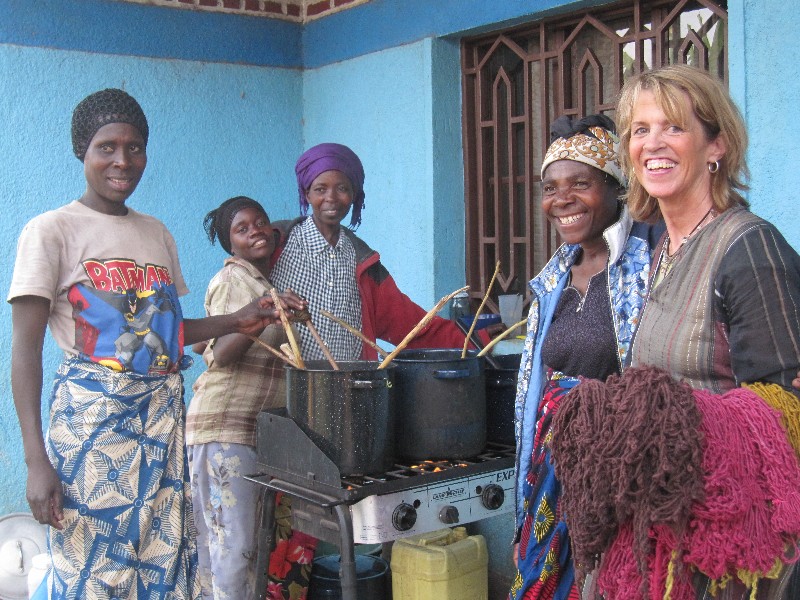

Sensing an end to the days of our visiting and traveling, Michele and I planned a trip to Granville Island, Vancouver, in the fall of 2013. I flew to Seattle, staying with Michele’s family. We had an amazing last minute chance to see jazz pianist Eliane Elias perform at Dimitriou's Jazz Alley. The next day we packed up and drove the roadways to Canada. We checked in to the Granville Island Hotel, and for a few days we wandered the island streets, in and out of art shops, bookstores, and Maiwa, ate lunches on the pier, savored dinners at the hotel and simply enjoyed the colors and energy of Granville Island. I will always treasure that memory.
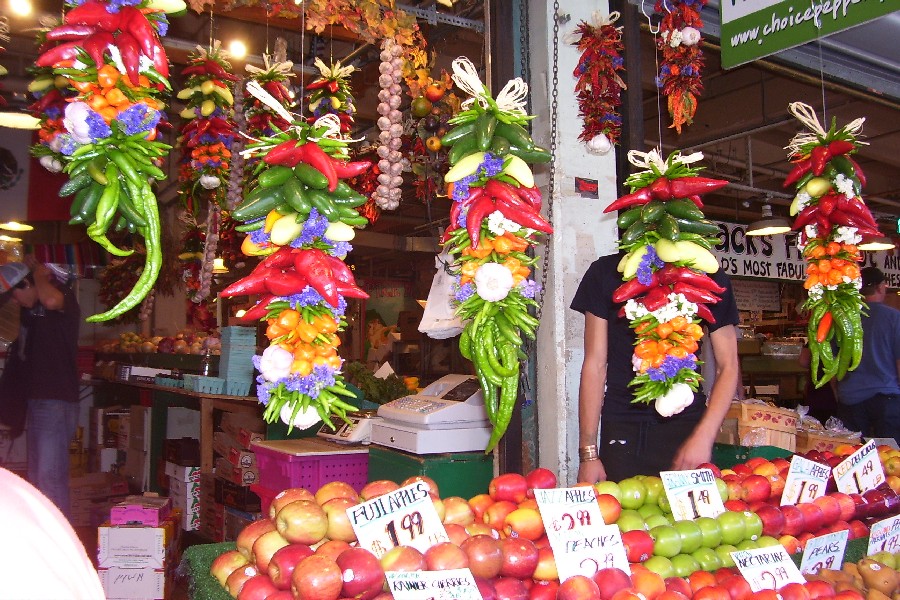
Michele gave so much over the years to the natural dye community. For me some are tangible and always treasured. A small oil painting hangs in my studio, painted by her father, of a hillside view with sheep and green pastures. Michele wanted me to have it after her dad passed away. It hangs to the right of my dye sink and it always reminds me of how art and friendship can come together in the most colorful way.
About the Author Nancy Zeller is a humanitarian, philanthropist, artist, natural dyer and shepherdess. Nancy holds a double major in BA in Art and Psychology. Her study of fiber arts has taken her around the world including the US, France, and Australia. Her first trip to Africa was in 2013 when she assisted a group of 35 Rwandan genocide widows expand their color line of handspun, naturally dyed yarns. On that trip she instantly was taken with the country of Rwanda and especially with its people. Their resiliency, creativity and deep optimism for a better future inspired her to start Rwanda-one4one, a non-profit 501(c)(3). In 2015 she conducted a research project to determine dye color properties of indigenous plants in Rwanda conducted through INES-Ruhengeri University in Rwanda. Nancy is celebrating nearly twenty years of operating Long Ridge Farm, located in Westmoreland, NH. There she raises Romeldale/CVM sheep, a breed of sheep considered endangered in the United States today (https://livestockconservancy.org/). She has a studio at the farm and hosts workshops and events that attract textile artists worldwide. For more information on Long Ridge Farm, go to https://longridgefarm.com/.
 Turkey Red Journal
Turkey Red Journal
